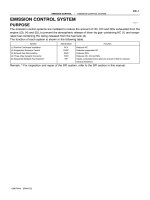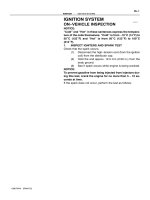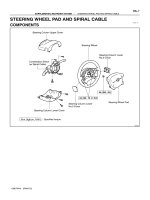11 2005 2006 toyota hilux factory service manual ignition system he thong danh lua
Bạn đang xem bản rút gọn của tài liệu. Xem và tải ngay bản đầy đủ của tài liệu tại đây (633.35 KB, 16 trang )
IG–4
1GR-FE IGNITION – IGNITION SYSTEM
ON-VEHICLE INSPECTION
1.
CHECK IGNITION COIL ASSEMBLY AND PERFORM
SPARK TEST
(a) Check for DTCs.
NOTICE:
If any DTC is present, perform troubleshooting
in accordance with a procedure for that DTC.
(b) Check that sparks occur.
(1) Remove the ignition coils.
(2) Using a 16 mm plug wrench, remove the spark
plugs.
(3) Install the spark plugs to each ignition coil, and
connect the ignition coil connectors.
(4) Disconnect the 6 injector connectors.
(5) Ground the spark plugs.
(6) Check if sparks occur at each spark plug while
the engine is being cranked.
NOTICE:
• Be sure to ground the spark plug when
checking.
• Replace the ignition coil if it receives an
impact.
• Do not crank the engine for more than 2
seconds.
If sparks do not occur, perform the following
test:
(c) Spark test flow chart.
(1) Check that the wire harness side connector of
ignition coil with igniter is securely connector.
Result
Result
Proceed to
NG
Connect securely.
OK
Go to next step.
(2) Perform spark test on each ignition coil with
igniter.
1.Replace ignition coil with igniter with a normal
one.
2.Perform spark test again.
Result
IG
Result
Proceed to
NG
Replace ignition coil with igniter.
OK
Go to next step.
(3) Check power supply to ignition coil.
1.Turn ignition switch ON.
2.Check that there is battery positive (+)
voltage at ignition coil positive (+) terminal.
Result
Result
Proceed to
NG
Check wiring between ignition
switch and ignition coil assembly.
OK
Go to next step.
IG–5
1GR-FE IGNITION – IGNITION SYSTEM
(4) Check resistance in VVT sensor out put voltage
(see step 2).
Result
Result
Proceed to
NG
Following test 1 and 2.
OK
Go to next step.
1. Check that the wiring between VVT sensor
and ECM.
Result
Result
Proceed to
NG
Repair wiring between VVT sensor
and ECM.
OK
Repair VVT sensor
(5) Check resistance in crankshaft position sensor.
Standard resistance
Standard condition
Specified condition
at 20°C (68°F)
1850 to 2450 Ω
Result
Result
Proceed to
NG
Replace the crankshaft position
sensor.
OK
Go to next step.
(6) Check IGT signal from ECM.
Result
Result
Proceed to
NG
Check ECM
OK
Repair wiring between ignition coil
and ECM.
(d) Using a 16 mm plug wrench, install the spark plugs.
(e) Install the ignition coils.
2.
CHECK SPARK PLUG
NOTICE:
• Never use a wire brush for cleaning.
• Never attempt to adjust the electrode gap on a
used spark plug.
• The spark plug should be replaced every 200,000
km (120,000 miles).
(a) Remove the engine cover.
(b) Remove the air cleaner.
(c) Remove the ignition coil.
(d) Remove the spark plug.
IG
IG–6
1GR-FE IGNITION – IGNITION SYSTEM
(e) Check the electrode.
(1) Using an ohmmeter, measure the insulation
resistance.
Correct insulation resistance:
10 MΩ or more
If the resistance is below the specified range,
remove the spark plug.
HINT:
If an ohmmeter is not available, perform the
following simple inspection.
OHMMETER
GROUND
A110413E04
(f)
Alternative inspection method:
(1) Quickly accelerate the engine to 4,000 rpm 5
times.
(2) Remove the spark plug.
(3) Visually check the spark plug.
If the electrode is dry, the spark plug is
functioning properly. If the electrode is damp,
proceed to the next step.
(g) Check the spark plug for any damage on its threads
and insulator.
If there is damage, replace the spark plug. If not,
reinstall the spark plug.
Recommended spark plug
B001301E01
Manufacturer
Spark Plug Type
DENSO
K20HR-U11
NGK
LFR6C11
(h) Check the spark plug electrode gap.
Standard electrode gap:
1.0 to 1.1 mm (0.039 to 0.043 in.)
If the electrode gap is larger than the standard,
replace the spark plug.
IG
Electrode Gap
A088861E02
IG–3
2TR-FE IGNITION – IGNITION SYSTEM
ON-VEHICLE INSPECTION
NOTICE:
In this section, the terms "cold" and "hot" refer to the
temperature of the coils. "Cold" means approximately 10 to 50°C (14 to 122°F). "Hot" means approximately 50 to
100°C (122 to 212°F).
1.
PERFORM SPARK TEST
(a) Check for DTCs.
NOTICE:
If a DTC is present, perform troubleshooting
procedures for that DTC.
(b) Check if sparks occur.
(1) Remove the ignition coil.
(2) Remove the spark plug.
(3) Install the spark plug to the ignition coil and
connect the ignition coil connector.
(4) Disconnect the 4 injector connectors.
(5) Ground the spark plug.
(6) Visually check that sparks occur while the
engine is being cranked.
NOTICE:
• Be sure to ground the spark plug when
checking.
• If the ignition coil has been struck or
dropped, replace it.
• Do not crank the engine for more than 2
seconds.
(c) Spark test flow chart.
(1) Check that the wire harness side connector of
the ignition coil with igniter is securely
connected.
Result
Result
Proceed to
NG
Connect securely
OK
Go to next step
(2) Perform spark test on each ignition coil with
igniter.
1. Replace ignition coil with igniter with a
normal one.
2. Perform spark test again.
Result
Result
Proceed to
OK
Replace ignition coil with igniter
NG
Go to next step
(3) Check power supply to ignition coil with igniter.
1. Turn the ignition switch ON.
IG
IG–4
2TR-FE IGNITION – IGNITION SYSTEM
2. Check that there is battery voltage at ignition
coil positive (+) terminal.
Result
Result
Proceed to
NG
Check wiring between engine switch
and ignition coil with igniter
OK
Go to next step
(4) Check resistance of camshaft position sensor.
Standard resistance
Temperature
Specified Condition
Cold
835 to 1,400 Ω
Hot
1,060 to 1,645 Ω
Result
Result
Proceed to
NG
Replace camshaft position sensor
OK
Go to next step
(5) Check resistance of crankshaft position sensor.
Standard resistance
Temperature
Specified Condition
Cold
1,690 to 2,740 Ω
Hot
2,065 to 3,225 Ω
Result
Result
Proceed to
NG
Replace crankshaft position sensor.
OK
Go to next step
(6) Check IGT signal from ECM.
Result
IG
Result
Proceed to
NG
Check ECM
OK
Repair wiring between ignition coil
and ECM
(d) Using a 16 mm plug wrench, install the spark plug.
Torque: 18 N*m (183 kgf*cm, 13 ft.*lbf)
(e) Install the ignition coil.
Torque: 9.0 N*m (92 kgf*cm, 80 in.*lbf)
2.
CHECK SPARK PLUG
NOTICE:
• Do not use a wire brush for cleaning.
• Do not attempt to adjust the electrode gap of a
used spark plug.
IG–5
2TR-FE IGNITION – IGNITION SYSTEM
Megaohmmeter
(a) Check the electrode.
(1) Using a megohmmeter, measure the insulation
resistance.
Insulation resistance:
10 MΩ or more
HINT:
If a megohmmeter is not available, perform the
following simple inspection instead.
Ground
A120009E01
P003783E01
1.1 mm
G037848E01
(b) Alternative inspection method:
(1) Quickly accelerate the engine to 4,000 rpm 5
times.
(2) Remove the spark plug.
(3) Visually check the spark plug.
If the electrode is dry, the spark plug is
functioning properly. If the electrode is damp,
proceed to the next step.
(c) Check the spark plug for any damage on its thread
and insulator.
If there is damage, replace the spark plug. If not,
reinstall the spark plug.
Recommended spark plug
Manufacturer
Spark Plug Type
DENSO made
SK20R11
NGK made
ILFR6C11
(d) Check the spark plug electrode gap.
Maximum electrode gap for used spark plug:
1.3 mm (0.051 in.)
If the gap is greater than the maximum, replace
the spark plug.
Electrode gap for new spark plug:
1.1 mm (0.043 in.)
NOTICE:
When adjusting the gap of a new spark plug,
bend only the base of the ground electrode. Do
not touch the tip. Never attempt to adjust the
gap of a used plug.
IG
IG–6
2TR-FE IGNITION – IGNITION SYSTEM
A050033E01
IG
(e) Clean the spark plugs.
If the electrode has traces of wet carbon, clean the
electrode with a spark plug cleaner and then dry it.
Air pressure:
588 kPa (6 kgf/cm2, 85 psi)
Duration:
20 seconds or less
HINT:
Only use the spark plug cleaner when the electrode
is free of oil. If the electrode has traces of oil, use
gasoline to clean off the oil before using the spark
plug cleaner.
1GR-FE IGNITION – IGNITION SYSTEM
IG–1
IGNITION SYSTEM
1GR-FE IGNITION
ENGINE
PARTS LOCATION
CAMSHAFT TIMING OIL
CONTROL VALUVE
VVT SENSOR
IGNITION COIL
CAMSHAFT TIMING OIL
CONTROL VALVE
VVT SENSOR
CRANK POSITION SENSOR
IG
A113581E01
IG–2
1GR-FE IGNITION – IGNITION SYSTEM
SYSTEM DIAGRAM
5 AM2
IG2
6
9
1B
10
1B
IGNITION
SWITCH
ECM
2A
4
2
GND
+B
IGF
IGT1
1
3
8
B16 IGT1
IGNITION COIL
4
2
NOISE
FILTER
GND
IGF
+B
IGT2
1
3
9
B16 IGT2
IGNITION COIL
4
2
2
GND
IGF
+B
IGT3
1
3
10
B16 IGT3
IGNITION COIL
30 A
AM2
4
2
2
GND
+B
IGF
IGT4
1
3
11
B16 IGT4
IGNITION COIL
4
2
IG
IGF
+B
IGT5
1
3
12
B16 IGT5
IGNITION COIL
J/C
4
BATTERY
GND
2
GND
IGF
+B
IGT6
IGNITION COIL
1
3
13
B16 IGT6
24
B16 IGF
G036237E01
IG–3
1GR-FE IGNITION – IGNITION SYSTEM
7
W1
3
VC
VVL+
VVL-
1
18
B18 VV2+
3
28
B18 VV2-
1
19
B18 VV1+
3
29
B18 VV1-
VVT SENSOR
6
W1
3
VC
VVR+
VVR-
VVT SENSOR
1
W1
1
23
B18 VC
20
B18 NE-
2
CRANKSHAFT POSITION SENSOR
21
B18 NE+
(SHIELD)
7
J/C
6
IG
ECM
G036238E01
1GR-FE IGNITION – IGNITION COIL
IG–7
IGNITION COIL
REMOVAL
1.
DISCONNECT CABLE FROM NEGATIVE BATTERY
TERMINAL
2.
REMOVE V-BANK COVER (See page ES-414)
3.
REMOVE AIR CLEANER ASSEMBLY (See page ES415)
4.
DISCONNECT VENTILATION HOSE
(a) Disconnect the ventilation hose from the intake air
surge tank.
5.
REMOVE IGNITION COIL ASSEMBLY
(a) Disconnect the 6 connectors.
(b) Remove the 6 bolts, then remove the 6 ignition
coils.
A075645E01
G036133E01
IG
IG–8
1GR-FE IGNITION – IGNITION COIL
INSTALLATION
IG
1.
INSTALL IGNITION COIL ASSEMBLY
(a) Install the 6 ignition coils with the 6 bolts.
Torque: 10 N*m (102 kgf*cm, 7.4 ft.*lbf)
(b) Connect the 6 ignition coil connectors.
2.
CONNECT VENTILATION HOSE
3.
INSTALL AIR CLEANER ASSEMBLY (See page ES416)
4.
INSTALL V-BANK COVER (See page ES-416)
5.
CONNECT CABLE TO NEGATIVE BATTERY
TERMINAL
Torque: 3.9 N*m (40 kgf*cm, 35 in.*lbf)
6.
INSPECT IGNITION TIMING (See page EM-1)
7.
INSPECT ENGINE IDLING SPEED (See page EM-2)
IG–8
1GR-FE IGNITION – VVT SENSOR
VVT SENSOR
REMOVAL
1.
DISCONNECT CABLE FROM NEGATIVE BATTERY
TERMINAL
2.
DRAIN ENGINE COOLANT (See page CO-3)
3.
REMOVE V-BANK COVER (See page ES-414)
4.
REMOVE AIR CLEANER ASSEMBLY (See page ES415)
5.
REMOVE VVT SENSOR
(a) RH bank side VVT sensor:
(1) Disconnect the VVT sensor connector.
(2) Remove the bolt and VVT sensor.
A076413E01
(b) LH bank side VVT sensor:
(1) Disconnect the water by-pass hoses No. 4 and
No. 5 .
(2) Disconnect the VVT sensor connector.
A076414E01
(3) Remove the bolt and VVT sensor.
IG
A076415E01
1GR-FE IGNITION – VVT SENSOR
IG–9
INSTALLATION
1.
INSTALL VVT SENSOR
(a) LH bank side VVT sensor:
(1) Apply a light coat of engine oil to the O-ring of
the VVT sensor.
(2) Install the VVT sensor with the bolt.
Torque: 8.0 N*m (82 kgf*cm, 71 in.*lbf)
(3) Connect the VVT sensor connector.
(4) Connect the water by-pass hoses No. 4 and
No. 5.
(b) RH bank side VVT sensor:
(1) Apply a light coat of engine oil to the O-ring of
the VVT sensor.
(2) Install the VVT sensor with the bolt.
Torque: 8.0 N*m (82 kgf*cm, 71 in.*lbf)
(3) Connect the VVT sensor connector.
2.
INSTALL AIR CLEANER ASSEMBLY (See page ES416)
3.
CONNECT CABLE TO NEGATIVE BATTERY
TERMINAL
Torque: 3.9 N*m (40 kgf*cm, 35 in.*lbf)
4.
ADD ENGINE COOLANT (See page CO-3)
5.
CHECK FOR ENGINE COOLANT LEAKAGE (See
page CO-4)
6.
INSTALL V-BANK COVER
(a) Install the V-bank cover with the 2 nuts.
Torque: 7.5 N*m (76 kgf*cm, 66 in.*lbf)
IG
IG–1
2TR-FE IGNITION – IGNITION SYSTEM
IGNITION SYSTEM
2TR-FE IGNITION
ENGINE
PARTS LOCATION
ECM
IGNITION COIL
CAMSHAFT POSITION SENSOR
SPARK PLUG
IG
CRANKSHAFT POSITION SENSOR
A113627E01
IG–2
2TR-FE IGNITION – IGNITION SYSTEM
SYSTEM DIAGRAM
Ignition Coil
AM2
IG2
+B
IGT1
Spark Plug
Ignition SW
IGF
IGT1
IGF1
GND
Ignition Coil
+B
AM2
IGT2
Spark Plug
IGT2
IGF
GND
Ignition Coil
+B
IGT3
Spark Plug
IGT3
IGF
GND
Ignition Coil
+B
IGT4
Spark Plug
Noise Filter
IGT4
IGF
GND
Comshaft Position Sensor
Rotor of
Comshaft
G2
G2
NE-
IG
Battery
Crankshaft Position
Sensor Sensor
Plate
NE+
NE-
NE+
NE-
E1
Crankshaft Position Sensor
E1
G038229E01









